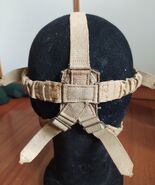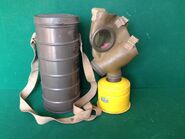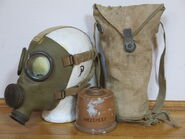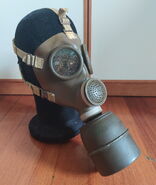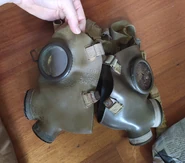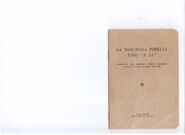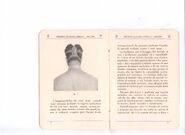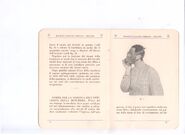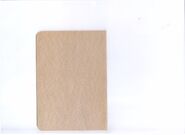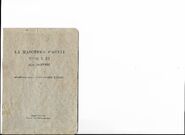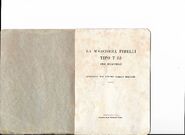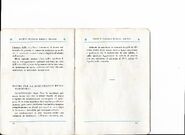The T.33 was an Italian territorial gas mask used by many non-combatant forces, civilians and industries.
Mask overview[]
The mask is composed of the following parts:
The faceblank, made of moulded rubber, has the following parts attached to it:
- the housing for the exhale valve
- the metal threaded piece that allows the filter to be screwed in and houses the intake valve
- the eyepieces
- the straps
The inhale valve allows filtered air in from the filter and does not allow exhaled air to go back out from the filter again. Said rubber valve is housed in the metal threaded piece.
The exhale valve allows exhaled air to go outside and prevents poisoned air to get in. It's made of rubber, it opens under the light pressure of exhaling and closes hermetically under the negative pressure produced by the inhalation. It can be easily inspected and possibly replaced by unscrewing the lid of its housing. The exhale valve is slightly different from that of the T.35, as the base rubber circle is slightly larger and therefore not interchangeable with the previously mentioned.
The eyepieces are made of "Triplex" glass, which itself is composed of two glass layers and a thin sheet of cellulose. This kind of glass prevents poisoned air to get into the mask even after being hit, as only the outside layer of glass would be shattered and the other two layers would maintain the seal. The glasses are affixed to the mask through aluminium frames.
The 5-strap system on this mask varied, with some having a hook system for the two lower straps and some having all the staps attached.
The anti-fogging disks are kept tightly onto the lenses by metal inserts and serve the purpose of maintaining good visibility.
Production differences[]
T.33 masks were produced with various furniture and markings, depending on the time of production.
Facepiece[]
sample text
Marking[]
Initially, the T.33 was used only in industries and by territorial forces, and the marking was simply "T.33" on the left temple, with the size marking under it.
After that, the T.33 was the 5thgas mask approved by the S.C.M. (Servizio Chimico Militare, chemical military service) on 31 August 1934 to be sold to civilians, and the masks produced were marked with the full license on the side.
-production number location-
Exhale valve cover[]
The exhale valve cover design varied over time, as at first, the mask was sold with a flat, gear-like cover, while later models had a rounder cover. Those covers are fully exchangeable and differ only in shape.
Strap system[]
The strap system could be either the regular, five-straps system like the one of the later T.35 or else it could be one that sports a hook system for the 2 lower straps, with 3 fixed straps. The latter of the two would be later used by the Ajax F2.
Kit[]
Civilian and territorial masks[]
Civilian T.33 masks were issued with a civilian filter (Yellow Dirin 500 type filters on the earliest kits, usually Dirzepo filters on later kits, but also occasionally Pir. 35 or T.35 filters), a tube carrier, anti-fogging soap (in alternative anti-fogging lenses on later kit) and a spare exhale valve in a small box.
Firefighters' kit[]
sample text
Industrial masks[]
Industrial T.33 masks had various available accessories. Starting from the filter, the mask could be issued with either a Dirin filter which was directly threaded to the mask or a larger filter (Tubin or Turnivercio) connected through a pleated hose of varying length. Those large filters could be carried either with a dedicated cage carrier or a standard Pirelli carrier-case. The mask was stored either in a metal box, a carrier-case or a Pirelli tube carrier, with the latter available only with T.33s with Dirin filters. The mask could also be sold with anti-fogging soap, anti-fogging lenses and spare exhale valves.
Hungarian kit[]
Just like the better known T.35, T.33 masks were also exported to Hungary but in much smaller numbers. The importer was Légoltalmi Kft. (Air defence Co.), which imported other Italian Pirelli masks like S.I.P. 3 with T.35 and Dirzepest filters as early as 1936. After the Bled agreement of 22 August 1938 Italy gifted some masks to Hungary. On 16 January 1939, the T.35 and T.33 with T.35 and Dirzepest filters went into service by Légoltalmi liga (the predecessor of Polgári védelem - Civil Defence) and Magyar Posta (Hungarian Post) as Gumi munkagázálarc or Mg. gázálarc (Rubber work gas mask). The price was the same as the M. gázálarc ; 23 Pengő with bag or 18,50 Pengő with cardboard carrier.
S.I.P. 6[]
main article: S.I.P. 6
Some T.33s had hoods permanently attached at the factory (along with other minor changes) and were designated as S.I.P. 6.
Clones[]
Ajax F2[]
main article: Ajax F2
The Ajax F2 was a French licensed copy of the Italian T.33 that sported a 42mm thread.













